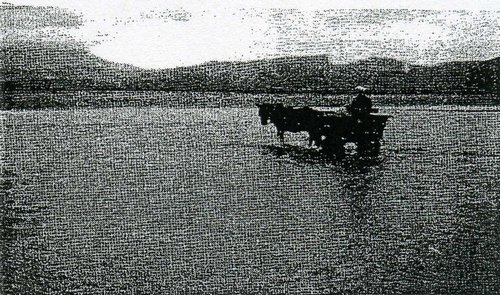One man that the village had a lot of respect for was Humphrey Owen, Draenogau Bach. He worked quite a lot with the horse and cart and before the Council had the lorry to take the rubbish away, Humphrey Owen did the job and as there were only dry lavatories then he also emptied them.
 The buckets were put out in the village and he also had to go to Soar. He took his load and dumped it in the traeth opposite Draenogau, and today old bottles and cans can be seen with other rubbish where he used to dump them in the holes 50 years or so ago. Humphrey Owen did the funerals as well as there was no motor hearse then only one that could be drawn with a horse. They kept the hearse on top of the hill near Capel Graig, where Mr. Campell keeps his car now. He carried the coal for the co-op and cattle feed for the farms as well, and for years generations of children thought the world of Humphrey Owen, as you never saw him coming through the village without a load of children singing away - he was their hero. Nearly all the land around the village belonged to the Cefn Trefor Bach estate but in 1921 it was sold in small parcels and before then it was owned by Edmund Roberts, a very busy man who was well liked in the Parish. He was a big chapel man, a Wesleyan; he played the organ in Soar and was also the Secretary or treasurer. He built Tremeifion but before that he lived in Cefntrefor Bach. (it is Cefntrefor Bach not Isa on the old maps.)
The buckets were put out in the village and he also had to go to Soar. He took his load and dumped it in the traeth opposite Draenogau, and today old bottles and cans can be seen with other rubbish where he used to dump them in the holes 50 years or so ago. Humphrey Owen did the funerals as well as there was no motor hearse then only one that could be drawn with a horse. They kept the hearse on top of the hill near Capel Graig, where Mr. Campell keeps his car now. He carried the coal for the co-op and cattle feed for the farms as well, and for years generations of children thought the world of Humphrey Owen, as you never saw him coming through the village without a load of children singing away - he was their hero. Nearly all the land around the village belonged to the Cefn Trefor Bach estate but in 1921 it was sold in small parcels and before then it was owned by Edmund Roberts, a very busy man who was well liked in the Parish. He was a big chapel man, a Wesleyan; he played the organ in Soar and was also the Secretary or treasurer. He built Tremeifion but before that he lived in Cefntrefor Bach. (it is Cefntrefor Bach not Isa on the old maps.)
It was Nelta Roberts' father who built Bronwylfa, before that they lived in `Angorfa' next door to Trefor Place, he was a Sea Captain and he lost his life during the first World War. Bryn Awel was the Wesleyan Minister's house and before that they lived in Brontrefor and they had a path that came out by Meirion and Rhiannon's bungalow (there was no bungalow there then and no trees and it was called `private field' as Edmund Roberts, Cefntrefor Bach had given permission to the Ministers to come through the field, but he did not want other people to use it. In the back of Capel y Graig, Willie Wiliams, the shoemaker bought land from Ty Mawr and built the Bungalow that is now called `Ceinfro' - this was in the early twenties and it was then an old Army Hut but he made a lot of alterations to it. `Trem-y-Wyddfa' was known as Snowdon View and Jonathan Parry lived there - he was a very good gardener and we always bought potatoes from him. He used to give us apples that had fallen off the trees and Mrs. Parry, his wife, was very well known, as people who sufferd with `Shingles' (eryr) went to her and she spat on it. They did say she could cure it as she had eaten an eagle at one time! I heard my mother saying about the people she had cured.
Our station master during the first World War was Mr. Pritchard, he had one son Stanley, he had lost his life in the war. Mrs. North was his housekeeper. There was always a porter in the station and the gates to the traeth were locked from the signal box on the platform and if the farmers wanted to go through they had to shout `gates' from the road. The police used to come to the village from Penrhyn and Harlech and they met on the Glyn Bridge once a month. They came on their bicycles. One man I should mention was Evan Williams, Maescaerau, he could handle the big axe and he used to swing the axe when he was cutting the big oak trees down in the Gelli and I can remember we had our sack ready for the chips for the fire.


